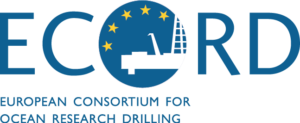 The deep seafloor is a complex bio-geosphere system in the world’s ocean environment, and only a small part of the interacting processes are understood. This not very well known system, though the largest on our planet, modulates global climate, global ocean circulation, contains to-days and future marine resources, and supports the largest biosphere on earth. Given such known importance, one of the aims of this workshop initiative is first to discuss and second to develop a perspective for an integrated science plan to study the deep sea floor system. This initiative aims to establish a major European research and technology effort for deep-sea floor science (DSFS) born by three large European geoscientific communities related to ocean drilling, ocean margin research, and sea-floor observations. The Deep-Sea Floor Initiative (DSF) has been initiated by ECORD-Net. It is supported through national, EC and ESF programmes, and ECORD.
The deep seafloor is a complex bio-geosphere system in the world’s ocean environment, and only a small part of the interacting processes are understood. This not very well known system, though the largest on our planet, modulates global climate, global ocean circulation, contains to-days and future marine resources, and supports the largest biosphere on earth. Given such known importance, one of the aims of this workshop initiative is first to discuss and second to develop a perspective for an integrated science plan to study the deep sea floor system. This initiative aims to establish a major European research and technology effort for deep-sea floor science (DSFS) born by three large European geoscientific communities related to ocean drilling, ocean margin research, and sea-floor observations. The Deep-Sea Floor Initiative (DSF) has been initiated by ECORD-Net. It is supported through national, EC and ESF programmes, and ECORD.
The imminent goal of the DSF is to deliver a science plan enabling to build the necessary support for integrative research of complex and interlinked physical, geological, chemical, biological and microbial processes operating throughout the global deep sea floor.
Understanding of the seabed has advanced due to more than a century of ship based expeditions and several decades of ocean drilling, ocean dives and ocean floor sampling and mapping. However, as our insights towards the coupling of the deep-sea bio-geosphere and submarine bedforms have developed over the last decade, it has become increasingly apparent that new in-situ approaches are needed.
Therefore, among many other technologies laboratories working on or close to the seabed are to be designed as our research advances.
Bringing it together
 Future studies of the seabed call for an interactive and integrated network of sophisticated sensors covering the interacting environments of microbial, chemical and geological processes. A variety of individual national programmes have started, and the research community in Europe now requests the infrastructure to build a leading role in deep-sea research and technology. One example is a breakthrough in technology and knowledge regarding biogeochemical and microbial processes related to anaerobic oxidation of methane. Methane is a major greenhouse gas, thus it is very important to understand the role of the seabed processes for transporting methane into the ocean and atmosphere. Another example is a breakthrough in technology, which allowed probing and discovering the world of deep-bacteria in bore holes of the IODP. A first milestone was reached by implementing the ‘Deep-Sea Frontier Workshop: an integrated an approach to study the deep-sea floor and its history’ – June 1-2, 2006 – in Naples, Italy, which brought together 70 representatives from the oil industry as well as programme managers and administrators of national and European funding agencies (left). The aim of the workshop was the identification of research needs and new research targets in European marine sciences, as well as a better integration of the involved scientific fields to create joint research programmes in deep sea floor science for the next decade.
Future studies of the seabed call for an interactive and integrated network of sophisticated sensors covering the interacting environments of microbial, chemical and geological processes. A variety of individual national programmes have started, and the research community in Europe now requests the infrastructure to build a leading role in deep-sea research and technology. One example is a breakthrough in technology and knowledge regarding biogeochemical and microbial processes related to anaerobic oxidation of methane. Methane is a major greenhouse gas, thus it is very important to understand the role of the seabed processes for transporting methane into the ocean and atmosphere. Another example is a breakthrough in technology, which allowed probing and discovering the world of deep-bacteria in bore holes of the IODP. A first milestone was reached by implementing the ‘Deep-Sea Frontier Workshop: an integrated an approach to study the deep-sea floor and its history’ – June 1-2, 2006 – in Naples, Italy, which brought together 70 representatives from the oil industry as well as programme managers and administrators of national and European funding agencies (left). The aim of the workshop was the identification of research needs and new research targets in European marine sciences, as well as a better integration of the involved scientific fields to create joint research programmes in deep sea floor science for the next decade.
During this workshop, experts from a wide range of scientific disciplines such as geophysics, seismology, sedimentology, geochemistry, paleontology, paleoclimatology, paleooceanography, marine geology, volcanology, marine biology, microbiology, fisheries, and marine policy jointly discussed the challenges, chances and threats of innovative research and technology developments in marine sciences. Six scientific target fields were identified as major foci for this new initiative:
1. History and prediction of geohazards
2. Fluid seeping and bacteria – affecting margins, oceans and the atmosphere
3. Climatic control and feed backs in the deep-sea environment
4. Development and conservation of deep sea ecosystems
5. The deep-sea landscape – sediment transport and fluxes
6. Sustainable exploitation of deep sea resources
Working groups were assigned to develop a science plan leading to integrative research on the deep sea floor for the upcoming decade. The capability of European marine geosciences and technology on the deep sea floor is to be significantly improved in areas where IODP starts probing the marine deep biosphere, where academic geoscience is starting 3D seismic reflection imaging, where the overall importance of the marine methane cycle to the broad earth science community is picking up but still remains a major unknown, and where now the overall importance of geohazards, climate control, ecosystems, and sustainable exploitation of deep sea resources has been widely recognized.
On the basis of the outcomes of the workshop a “Foresight Paper” on deep-sea research for the next decade entitled Download has been published by the Steering Committee of the DSF, which includes 12 representatives of the respective European research programmes.
DSF STEERING COMMITTEE
Miquel Canals / Catherine Mével
Pierre Cochonat / Jürgen Mienert (co-chair)
Sören Dürr (co-chair) / Chris MacLeod
Paolo Favali / Roland Person
Anthony Grehan / Ralph Schneíder
Peter Herzig / Phil Weaver
John Ludden / Amelie Winkler

